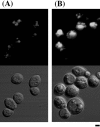DGA1 (diacylglycerol acyltransferase gene) overexpression and leucine biosynthesis significantly increase lipid accumulation in the Deltasnf2 disruptant of Saccharomyces cerevisiae
- PMID: 17688423
- PMCID: PMC2049070
- DOI: 10.1042/BJ20070449
DGA1 (diacylglycerol acyltransferase gene) overexpression and leucine biosynthesis significantly increase lipid accumulation in the Deltasnf2 disruptant of Saccharomyces cerevisiae
Abstract
We previously found that SNF2, a gene encoding a transcription factor forming part of the SWI/SNF (switching/sucrose non-fermenting) chromatin-remodelling complex, is involved in lipid accumulation, because the Deltasnf2 disruptant of Saccharomyces cerevisiae has a higher lipid content. The present study was conducted to identify other factors that might further increase lipid accumulation in the Deltasnf2 disruptant. First, expression of LEU2 (a gene encoding beta-isopropylmalate dehydrogenase), which was used to select transformed strains by complementation of the leucine axotroph, unexpectedly increased both growth and lipid accumulation, especially in the Deltasnf2 disruptant. The effect of LEU2 expression on growth and lipid accumulation could be reproduced by adding large amounts of leucine to the culture medium, indicating that the effect was not due to Leu2p (beta-isopropylmalate dehydrogenase) itself, but rather to leucine biosynthesis. To increase lipid accumulation further, genes encoding the triacylglycerol biosynthetic enzymes diacylglycerol acyltransferase (DGA1) and phospholipid:diacylglycerol acyltransferase (LRO1) were overexpressed in the Deltasnf2 disruptant. Overexpression of DGA1 significantly increased lipid accumulation, especially in the Deltasnf2 disruptant, whereas LRO1 overexpression decreased lipid accumulation in the Deltasnf2 disruptant. Furthermore, the effect of overexpression of acyl-CoA synthase genes (FAA1, FAA2, FAA3 and FAA4), which each supply a substrate for Dga1p (diacylglycerol acyltransferase), was investigated. Overexpression of FAA3, together with that of DGA1, did not further increase lipid accumulation in the Deltasnf2 disruptant, but did enhance lipid accumulation in the presence of exogenous fatty acids. Lastly, the total lipid content in the Deltasnf2 disruptant transformed with DGA1 and FAA3 overexpression vectors reached approx. 30%, of which triacylglycerol was the most abundant lipid. Diacylglycerol acyltransferase activity was significantly increased in the Deltasnf2 disruptant strain overexpressing DGA1 as compared with the wild-type strain overexpressing DGA1; this higher activity may account for the prominent increase in lipid accumulation in the Deltasnf2 disruptant with DGA1 overexpression. The strains obtained have a lipid content that is high enough to act as a model of oleaginous yeast and they may be useful for the metabolic engineering of lipid production in yeast.
Figures



Similar articles
-
Activation of diacylglycerol acyltransferase expressed in Saccharomyces cerevisiae: overexpression of Dga1p lacking the N-terminal region in the Deltasnf2 disruptant produces a significant increase in its enzyme activity.Appl Microbiol Biotechnol. 2010 Sep;88(1):105-15. doi: 10.1007/s00253-010-2725-x. Epub 2010 Jun 22. Appl Microbiol Biotechnol. 2010. PMID: 20567816
-
Overexpression of the active diacylglycerol acyltransferase variant transforms Saccharomyces cerevisiae into an oleaginous yeast.Appl Microbiol Biotechnol. 2013 Aug;97(16):7345-55. doi: 10.1007/s00253-013-4915-9. Epub 2013 Apr 24. Appl Microbiol Biotechnol. 2013. PMID: 23613035
-
Increase in stearidonic acid by increasing the supply of histidine to oleaginous Saccharomyces cerevisiae.J Biosci Bioeng. 2014 Jan;117(1):53-6. doi: 10.1016/j.jbiosc.2013.06.004. Epub 2013 Aug 6. J Biosci Bioeng. 2014. PMID: 23932357
-
Advancing oleaginous microorganisms to produce lipid via metabolic engineering technology.Prog Lipid Res. 2013 Oct;52(4):395-408. doi: 10.1016/j.plipres.2013.05.002. Epub 2013 May 16. Prog Lipid Res. 2013. PMID: 23685199 Review.
-
Leucine biosynthesis in fungi: entering metabolism through the back door.Microbiol Mol Biol Rev. 2003 Mar;67(1):1-15, table of contents. doi: 10.1128/MMBR.67.1.1-15.2003. Microbiol Mol Biol Rev. 2003. PMID: 12626680 Free PMC article. Review.
Cited by
-
De novo transcriptomic analysis of Chlorella sorokiniana reveals differential genes expression in photosynthetic carbon fixation and lipid production.BMC Microbiol. 2016 Sep 26;16(1):223. doi: 10.1186/s12866-016-0839-8. BMC Microbiol. 2016. PMID: 27669744 Free PMC article.
-
Increased Accumulation of Squalene in Engineered Yarrowia lipolytica through Deletion of PEX10 and URE2.Appl Environ Microbiol. 2021 Aug 11;87(17):e0048121. doi: 10.1128/AEM.00481-21. Epub 2021 Aug 11. Appl Environ Microbiol. 2021. PMID: 34132586 Free PMC article.
-
Cinnamon Polyphenol Extract and Insulin Regulate Diacylglycerol Acyltransferase Gene Expression in Mouse Adipocytes and Macrophages.Plant Foods Hum Nutr. 2019 Mar;74(1):115-121. doi: 10.1007/s11130-018-0709-7. Plant Foods Hum Nutr. 2019. PMID: 30637573
-
Identification of propranolol and derivatives that are chemical inhibitors of phosphatidate phosphatase as potential broad-spectrum fungicides.Plant Commun. 2024 Jan 8;5(1):100679. doi: 10.1016/j.xplc.2023.100679. Epub 2023 Aug 30. Plant Commun. 2024. PMID: 37653727 Free PMC article.
-
Engineering yeast for tailored fatty acid profiles.Appl Microbiol Biotechnol. 2025 Apr 22;109(1):101. doi: 10.1007/s00253-025-13487-1. Appl Microbiol Biotechnol. 2025. PMID: 40263140 Free PMC article. Review.
References
-
- Daum G., Lees N. D., Bard M., Dickson R. Biochemistry, cell biology and molecular biology of lipids of Saccharomyces cerevisiae. Yeast. 1998;14:1471–1510. - PubMed
-
- Carman G. M., Henry S. A. Phospholipid biosynthesis in the yeast Saccharomyces cerevisiae and interrelationship with other metabolic processes. Prog. Lipid Res. 1999;38:361–399. - PubMed
-
- Oelkers P., Tinkelenberg A., Erdeniz N., Cromley D., Billheimer J. T., Sturley S. L. A lecithin cholesterol acyltransferase-like gene mediates diacylglycerol esterification in yeast. J. Biol. Chem. 2000;275:15609–15612. - PubMed
-
- Lardizabal K. D., Mai J. T., Wagner N. W., Wyrick A., Voelker T., Hawkins D. J. DGAT2 is a new diacylglycerol acyltransferase gene family. J. Biol. Chem. 2001;276:38862–38869. - PubMed
MeSH terms
Substances
LinkOut - more resources
Full Text Sources
Other Literature Sources
Molecular Biology Databases
Research Materials

